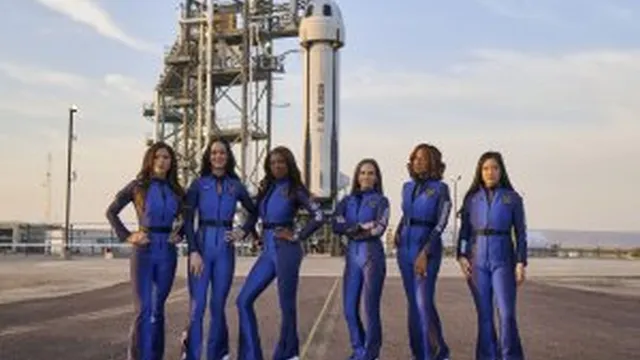
Katy Perry and Gayle King take to the stars on Blue Origin rocket
2025-04-19 09:45- Katy Perry and Gayle King were part of an all-female crew that launched into space on April 14, 2025.
- The New Shepard rocket successfully took off and landed, completing the mission in eleven minutes.
- This flight highlights the growing diversity and opportunities for women in the space exploration field.
Express your sentiment!
Insights
On April 14, 2025, Katy Perry, the renowned pop singer, and Gayle King, a well-known television host, embarked on a historic journey into space as part of Blue Origin's eleventh space tourism launch. This significant event took place at Blue Origin's Launch Site One, located roughly 30 miles outside of Van Horn, Texas. The mission, named NS-31, was comprised entirely of women, showcasing the capabilities of female explorers in the realm of space travel. The launch occurred at 9:30 a.m. EDT, with the New Shepard suborbital vehicle successfully lifting off. The crew's journey lasted a mere eleven minutes, during which they reached the Karman line, the boundary where Earth’s atmosphere transitions to outer space. At 9:39 a.m., the New Shepard vehicle made its descent, and by 9:42 a.m., the crew landed safely back on Earth, parachuting down to their capsule with a puff of dust. Shortly after 9:50 a.m., the exhilarated astronauts emerged from their capsule, concluding a historic flight that offered them a brief experience of weightlessness, lasting approximately four minutes. During the flight, Katy Perry, with her signature enthusiasm, expressed her excitement about the adventure, and even teased a special announcement to be made once they reached zero gravity. The crew comprised several notable figures, including former rocket scientist Aisha Bowe, researcher Amanda Nguyen—who has been nominated for a Nobel Prize—filmmaker Kerianne Flynn, and journalist Lauren Sanchez, in addition to Perry and King. Their presence on this mission illustrates a growing recognition of diversity within the field of space exploration. Oprah Winfrey was present during the launch and captured moments that highlighted the emotional significance for Gayle King, who displayed a rare expression of vulnerability prior to the launch, wiping away tears as she reflected on the monumental journey ahead. The significance of this mission goes beyond just personal achievements; it represents a pivotal moment in the history of space tourism, where accomplishments are not just measured by the technology involved but also by the inspiring stories and motivations of the individuals who partake in such groundbreaking endeavors. With figures like Perry and King taking center stage, there is a strong possibility that more women will be encouraged to pursue careers in science, technology, engineering, and mathematics (STEM), creating a ripple effect of inspiration for future generations. This launch, while brief, opens the door for further advancements in space tourism and emphasizes the need for public engagement in the exploration of space.
Contexts
The Karman line, situated at an altitude of 100 kilometers (62 miles) above sea level, is widely recognized as the boundary between Earth's atmosphere and outer space. Named after Hungarian-American engineer and physicist Theodore von Karman, this demarcation is not merely a theoretical construct but a significant threshold for various scientific, engineering, and aerospace applications. The Karman line serves as an important reference point for numerous global regulatory frameworks, including those governing spaceflight and aviation, providing clarity on the status of vehicles that cross this boundary. With the increasing number of commercial spaceflights and satellites being launched, the Karman line has gained importance as a means to define the operational limits between air-breathing aircraft and spacecraft, ultimately influencing what constitutes a 'spacecraft' for both legal and technical purposes. From a scientific perspective, the Karman line marks a transition in atmospheric pressure, density, and composition, where the atmosphere becomes exceedingly thin. Above this altitude, the behavior of spacecraft changes significantly; conventional aerodynamic principles cease to apply, and the dynamics of flight shift towards orbital mechanics. In practical terms, reaching the Karman line is often viewed as the threshold for entering space, which has implications for research and exploration missions. This transition zone has critical relevance for scientists studying the Earth's atmosphere, as it provides insights into atmospheric layers, cosmic rays, and the effects of space on biological organisms, thus fueling advancements in aerospace medicine and investigation into the long-term impacts of space travel on human physiology. The Karman line also presents a host of challenges for engineers and researchers. Vehicles designed for space travel must cope with the harsh conditions of space, including temperature variations, radiation exposure, and the vacuum of space. The transition over the Karman line demands precise planning, innovative engineering solutions, and robust materials capable of enduring these extreme environments. As technology advances and private companies increasingly enter the realm of space exploration, the implications of breaching the Karman line expand to encompass innovations such as reusable rocket systems, suborbital flights for tourists, and exploration missions to other celestial bodies. Furthermore, reaching the Karman line has become a symbolic milestone in human endeavor. It is celebrated as a testament to human ingenuity and the relentless pursuit of knowledge and exploration beyond our home planet. This threshold is revered by space enthusiasts and the scientific community alike, representing not only the boundary to celestial exploration but also reflecting on the broader philosophical implications of humanity's place in the universe. As society ventures deeper into the final frontier, the Karman line will remain a pivotal reference point, encapsulating both the challenges and aspirations of contemporary space endeavors.